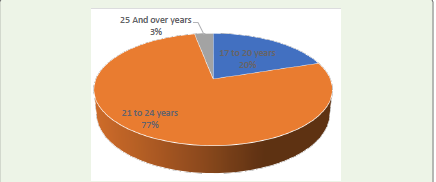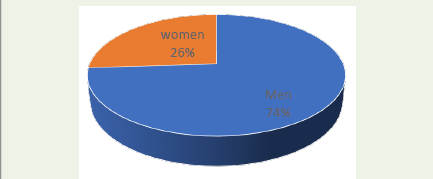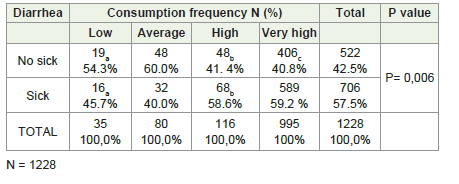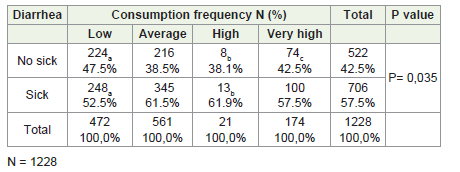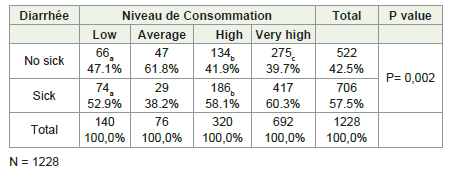Research Article
Prospective Analyze of the Relationship between the Dietary Profile and the Frequent Occurrence of Diarrhea among Students in Ivory Coast
Anon Franck-Donald N’Guessan1*, Kollet Yao Aimé Sylvère ZAHE2, N’da Mireille-Vanessa Yoboué4, AHOUA Yapi5, and AKE-TANO Sassor Odile Purifine5
1National Institute of Public Health, Abidjan, MSHPCMU Ivory Coast
2Laboratory of Pharmacology and Nutrition, Félix Houphouët BOIGNY University Abidjan, Ivory Coast
3UNESCO Chair, Félix Houphouët-Boigny University Abidjan, Ivory Coast
4Félix Houphouët Boigny University Abidjan, Ivory Coast
5Félix Houphouët BOIGNY University Abidjan, Ivory Coast
5Félix Houphouët BOIGNY University Abidjan, Ivory Coast,National Institute of Public Health, Abidjan, MSHPCMU Ivory Coast,
2Laboratory of Pharmacology and Nutrition, Félix Houphouët BOIGNY University Abidjan, Ivory Coast
3UNESCO Chair, Félix Houphouët-Boigny University Abidjan, Ivory Coast
4Félix Houphouët Boigny University Abidjan, Ivory Coast
5Félix Houphouët BOIGNY University Abidjan, Ivory Coast
5Félix Houphouët BOIGNY University Abidjan, Ivory Coast,National Institute of Public Health, Abidjan, MSHPCMU Ivory Coast,
*Corresponding author:Anon Franck-Donald N’Guessan, National Institute of Public Health, Abidjan, MSHPCMU Ivory Coast, Email: anonfranc@gmail.com
Article Information: Submission: 11/03/2024; Accepted: 07/06/2024; Published: 10/06/2024
Copyright: © 2024 Anon Franck-Donald N’Guessan, et al. This is an open access article distributed under the Creative Commons Attribution License, which permits unrestricted use, distribution, and reproduction in any medium, provided the original work is properly cited.
Abstract
In 2016, the work of [1] showed a high prevalence of digestive disorders such as diarrhea in the student population of the Felix HouphouëtBoigny University in Côte d’Ivoire. Given the known relationship between Diarrhea and eating behaviors, a nutritional and health epidemiology survey was carried out from October 15, 2016 to February 17, 2017. The objective of the study was to research the link between food consumption and episodes of diarrhea encountered among students. For this purpose, 1,228 student volunteers volunteered and were surveyed. The study confirmed the high prevalence of acute
diarrhea (57.5%) among students. After analyzing the relationship between eating habits and disease, it turned out that high consumption of spicy foods, sweet foods, foods containing eggs or milk were strongly involved. In view of these results, it would be important to carry out studies to evaluate the health safety of
foods consumed on the Cocody University campus and also organize nutritional education sessions in all university campuses in the country with a view to an improvement in their eating habits and their health.
Keywords:Students; Food Habits; Digestive Pathologies; Diarrhea
Introduction
Diarrhea is defined as the passing of stools that are too frequent,
greater than three exonerations per day, too abundant (more than
300g/day) and of abnormal consistency (very soft to liquid). Most
often, it is characterized by a sudden onset and a favorable evolution.
Depending on its duration, it is considered acute or chronic if
it persists for less or more than 14 days [2]. Generally due to an
infectious bacterial, viral or parasitic cause, it is frequently linked to
the absorption of food or non-food substances [3]. Indeed, whatever
the causal mechanism, eating habits occupy an important place
among the factors favoring attacks of acute or chronic diarrhea[4].
In developed countries, there is approximately one acute episode
per inhabitant per year [5]. On the other hand, in developing
countries, the prevalence is much higher, especially among children
and not negligible among young adults including students[6].
In Ivory Coast, a nutritional epidemiological study carried out
in 2016 revealed a high prevalence of digestive pathology (63.28%),
including acute diarrhea, among students [1].In view of this
situation, it would be important to investigate the reasons, with a view
to proposing appropriate and adapted solutions. It is in this context
that a nutritional epidemiological survey was carried out at the Felix
HouphouëtBoigny University, in order to describe the eating habits
of students and to analyze their implications in the occurrence of
diarrhea attacks.
Material and Methods of the Study
Material:
Framework of the study: The study was carried out in West
Africa, in Ivory Coast precisely at the Félix HouphouëtBoigny
University of Cocody in Abidjan. It was carried out from October
15, 2015 to February 17, 2016 with student volunteers. The latter
spending more time on campus during the school year, generally
eat in the university’s restaurants and surrounding restaurants. The
university has a public restaurant, with subsidized meals, and several
other restaurants, offering various dishes (rice, foutou, foufou,
attiéké, placali and tôh) accompanied by sauces such as peanut sauces,
pistachio, palm seeds and vegetables. Sauces usually contain fish or
meat. Around the university, several small businesses also offer food
to students. These include roasted peanuts, pancakes, cakes, wheat
flour croquettes and bread with various accompaniments (avocado,
soy, fish, meat, eggs, pasta, potatoes, etc.). These dishes are often
accompanied by drinks (water, sweetened industrial soft drinks and
traditional sweetened fruit juices).Study Population (inclusion and non-inclusion criteria):
Any student enrolled in the second year of Chemistry Biology
Geology (CBG) at Félix Houphouët-Boigny University who wished
to participate in the study was included in this study.They were not included in the study, as all other people did not
respect the conditions raised.
Data Collection Tools:
The survey data was collected using a questionnaire designed for
this purpose and validated by a pre-survey of 45 students from the
Agrhymet Regional Center of NIAMEY (NIGER). It is structured
in three parts: (i) the first part retraced the socio-demographic
characteristics of the study population (ii) the second revealed the
medical histories regularly experienced by the patients over a period
of one year while (iii) the third part was reserved for eating habits
(Frequency of food consumption).Methods:
Type of study: This is a prospective cross-sectional study with a
descriptive and analytical aim based on a food consumption survey
associated with a nutritional and health assessment.Sampling:
A total of 1228 male and female students volunteered to
participate in the study.Diagnosis:
The diagnosis of diarrhea was essentially clinical during this work.
Indeed, our investigation consisted solely of a clinical examination
consisting of a questioning.Individuals who had frequently passed stools over the last 6
months that were too frequent, too abundant compared to usual and
of abnormal consistency (very soft to liquid) were considered sick,
Statistical analysis:
Quantification of the frequency of food consumption:
Food consumption is categorized based on the methods used
[1]and [7]. Indeed, food consumption was evaluated by the food
consumption frequency method and by the retrospective study of
eating behavior, readjusted over one week.When the consumption of a food is less than once to once a week, it is considered low.
When consumption is 2 times a week, it is considered average.
When consumption is 3 to 4 times per week, it is considered strong.
When consumption is 5 to 7 times per week, it is considered very strong.
- Quantification of the frequency of water consumption: When water consumption is less than one liter outside of meals per day, it is considered low.
When water consumption is 1 to less than 1.5 liters outside of meals per day, the consumption is considered average.
Processing of qualitative and quantitative data:
Quantitative and qualitative data were collected. The analysis
was done with SPSS 20.0 software. For quantitative variables, the
mean, standard deviation, and extreme values were highlighted. At
the level of qualitative variables, the distribution and comparison of
proportions was retained.Ethical aspects:
With regard to ethical considerations, the volunteers were
informed of all stages before the start of the investigation and
were interviewed or examined after free and informed consent.
Confidentiality was assured by assigning an anonymity number to
each survey sheetResults
Socio-Demographic Characteristics:
In terms of sociodemographic criteria, three parameters were
analyzed, namely ethnic group, age and gender.Regarding the ethnic group, the Akans are the most represented
with a number of 621 people, the Krous, the Northern Mandé and the
Gour are respectively 161, 109 and 182 and the foreigners are the least
represented with a workforce of 31 people [Figure 1]. Regarding the
age of the respondents, the age of the population was subdivided into
3 groups. Thus, respondents aged 17 to 19 years old are 20% and those
aged 20 to 24 years old and 25 and over are 77% and 3% respectively
[Figure 2]. And in this population, 74% are men compared to 26%
women [Figure 3].
Food Habits and Occurrence of Diarrhea:
The analysis of the relationship between eating habits and
the occurrence of diarrhea in the study population revealed the
involvement of a high consumption of foods sweetened and or
containing eggs or milk (P= 0,006), fruit and vegetables (P= 0,035)
and spicy products (P= 0,002).However, no link exists concerning red
meat/animal fat, fish, white meat, vegetable fat, cereals, tubers, soft
drinks, and flavor enhancing products.Discussion
During this study the predominant ethnic group was the Koua
Akan with 51% of respondents. This could be explained by the
geographical location of the Félix HouphouëtBoigny University of
Abidjan, which is more accessible to this ethnic group, especially
because the biosciences specialty is found in other universities in the
country located in the North and in the center-West. These results are
comparable to those of Amoikon et al in 2016 [1].
The study population was young with an average age of 22.5
years and dominated by men with a sex ratio of 2.84 in favor of men.
This could be explained by the fact that in Ivory Coast the level of
education of young boys is higher than that of young girls.[8].In the
population a prevalence of 57.5% of diarrhea was recorded. These
results are superimposable to those of Amoikon et al (2016)[1].
Table 1:The relationship between the level of consumption of food containing
eggs or milk or sugar and the occurrence of diarrhea.
Table 2:The relationship between the level of fruit and vegetable consumption
and the occurrence of diarrhea.
The health status assessment was carried out and cross-referenced
with the level of food consumption. This analysis highlighted a
relationship between high consumption of sugary foods containing
eggs or milk, fruits and vegetables, and spicy products, and the
occurrence of diarrhea among students.
In terms of fruits, vegetables, sweet foods containing eggs or milk,
the results are comparable to WHO data (WHO, 2017).
Indeed, according to the WHO, poor hygiene linked to the
storage, preparation and consumption of sweet foods, containing eggs
or milk, and fruits and vegetables, could be a source of contamination
of Salmonella, Campylobacter, Entero-hemorrhagic Escherichia coli,
Listeria, Vibrio-cholerae, Entamoeba-histolica, or Giardia intestinalis
all responsible for acute or chronic diarrhea in humans.
Also, sugary foods, foods containing eggs or milk, have a
recognized reputation for the occurrence of irritable bowel syndrome
including chronic diarrhea[9-11](Talley, 2006), [4] (Xiong L et al,
2017), [10](Olesen ,2017), [11] (Sabaté, 2013).
Concerning spicy products, it is recognized that they have the
capacity to accelerate transit and to cause in high doses (depending
on personal sensitivities) attacks of diarrhea in certain people who are
allergic or sensitive to them [12] (Nancey, 2005), [11] (Sabaté, 2013), [13] (hordé, 2014). Food allergies, in fact, are immune reactions of
the body to the ingestion of a food that is usually well tolerated by the
majority [14] (Biérmé, 2017). In the event of prolonged exposure to
causal dietary factors such as spices in sensitive subjects, there is either
a reduction in the intensity of intestinal peristalsis which can lead to
constipation or an acceleration of transit leading to the occurrence of
diarrhea. [15,16](Chaput, 2004, Akuete et al., 2017).
At the end of this analysis, it is remarkable that the high
consumption of certain foods is actually involved in the occurrence
of diarrhea attacks in the population. Furthermore, poor hygiene
linked to the storage, preparation and consumption of foods such as
sweet foods containing eggs or milk, fruits and vegetables, could be
a source of bacterial, parasitic or viral contamination responsible. of
acute or chronic diarrhea among students at Felix HouphouëtBoigny
University in Cocody.
Conclusion
Eating habits, when they are not rationalized and taken care
of, they weaken the body and expose it to acute or chronic and
serious illnesses. This study revealed a relationship between high
consumption of spicy foods, sweet foods, foods containing eggs and/
or milk and the occurrence of diarrhea. Furthermore, it is notable that
the lack of respect for hygiene measures linked to the conservation,
preparation and consumption of certain foods (sweet foods or foods
containing eggs or milk, and fruit and vegetables), could be a source
of bacterial, parasitic or viral contamination responsible for acute and
chronic diarrhea in student’s population.
In view of these results, we will carry out studies to evaluate the
health safety of foods consumed on the CocodyUniversity campus,
then we will organize nutritional education sessions in all university
campuses in the country with a view to improving their eating habits
and health conditions.


